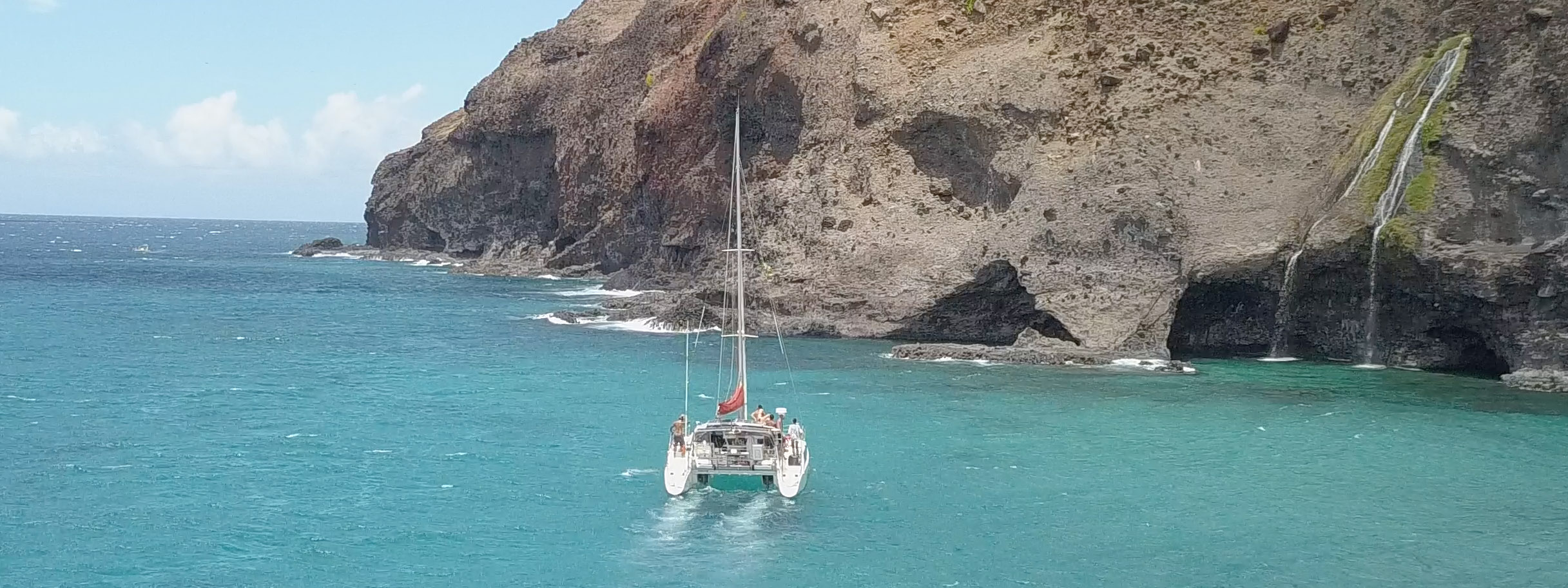Frequently Asked Questions about Sailing Kauai

Why choose NaPali Makai charters?
NaPali tour Boat with the least environmental impact
• Mostly sail and use small eco friendly outboards, zero (Sail) to low carbon emissions (Eco friendly outboards, very low carbon emissions).
• Aware of climate change & global warming
• Eco Conscious, low carbon footprint
• Support eco tourism through sustainable boating
• NaPali tour boat with the least environmental impact
• Use only reef safe sun screen while snorkeling
• No single use plastic water bottles
• Use mostly local and organic food.
• Hawaiian owned and operated business
• Captain Makai is a professional waterman, and grew up on a sailboat with over 25years experience working on tour boats in Hawaii.
How long does it take to get to the Harbor? Where are you located?
- There are no freeways! Yay! so 30 minutes is…30 minutes.
- We estimated your lifestyles and world clock, and chosen reasonable check-in hours.
- We are 3-6 hours behind your Western USA time, and for East Asia and Europe we are 3-12 hours ahead.
- Check-in is 7am for mornings. (Summer) Check-in is 1pm for afternoons. (Summer)
- The captain leaves 15 minutes after check-in.
- Please inform us of where your staying when you call in so we can better inform you.
- Winter and Whale Season Check-in is at 8am.
- Please call if you are running late so we can accommodate everyone accordingly.
- Depart from Northshores-Hanalei, Moloaa, Makana (Princeville): 1 hour and 30 minutes.
- Depart from Eastshores-Kapaa, Waipouli, Wailua, Lihue, Kalapaki, Nawiliwili: 45 min-1 hour.
- Depart from Southshores-Koloa, Poipu, Kalaheo: 30-45 minutes.
- Depart from Westshores-Kalaheo, Eleele (Port Allen), Waimea: 2-15 minutes.
- Directions will be provided with the Reservation Hold Confirmation Email.
- Google ™ Mapquest ™ Yahoo Map™ inform you that the dock is located in Waimea or Kekaha, but not the exact location.
- Please call us 72 hours ahead to reschedule at 808-639-9352.
- Your captain will give you a briefing before the tour departs.
Will the Kauai bus take me to the Check-In Location?
What if I am on the Norwegian Cruise Line (NCL)?
Where did Hawaiians come from?
Life in old Hawaii
How can we get to the Kalalau Valley and on to the beach?
Can you smoke on the Boat?
Cancellation Policy?
Cancellation must be done 48 hours before the Napali Makai Tour with full refund. No refunds after 48 hour.
How is the weather on Kauai?
How long is each tour?
What is the difference between a whale watching tour and the full 4 hour Napali Coast Tour?
What is your refund policy regarding the deposit?
What are some things I can do to prevent motion sickness?
What type of Dolphins can we see during the tour?
Should I bring sunscreen?
Please bring on the trip reef safe sunscreen to help keep our reefs healthy and thriving with fish. You can also bring a hat and sunglass to protect you from the strong sun here on Kauai.
Where does Napali Makia Sail
TOURING KAUAI
NA PALI COAST
HANALEI BAY
PRINCEVILLE
POIPU
NAWILIWILI HARBOR
